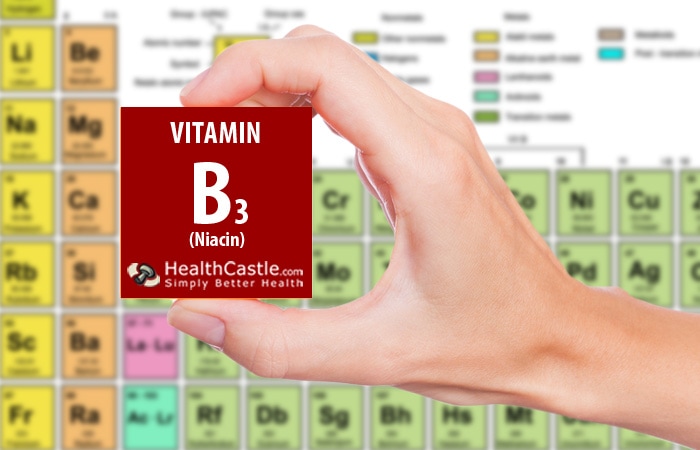
Written By: Carolyn Berry, RD
Title: Registered Dietitian
Alumni: University of British Columbia
Last Updated on:

Niacin, also known as vitamin B3, is one of eight B vitamins. All of the B vitamins are water-soluble, meaning that the body does not store them but excretes them in the urine. Other names for niacin include nicotinic acid and nicotinamide / niacinamide.
Table of Contents
| Age Group | Recommended Dietary Allowance (RDA) per day1 | Tolerable Upper Intake (UI) Levels2 |
| Adults | ||
| 19 years and up | 16 mg men 14 mg women | 35 mg |
| Kids and Youth | ||
| 1 to 3 years | 6 mg | 10 mg |
| 4 to 8 years | 8 mg | 15 mg |
| 9 to 13 years | 12 mg | 20 mg |
| 14 to 18 years | 16 mg male 14 mg female | 30 mg |
| Special Considerations | ||
| Pregnant women 14 to 18 years | 18 mg | 30 mg |
| Pregnant women 18 years and up | 18 mg | 35 mg |
| Lactating women 14 to 18 years | 17 mg | 30 mg |
| Lactating women 18 years and up | 17 mg | 35 mg |
Note: Niacin can be made in the body from tryptophan (an amino aciid). Therefore, the recommended intake for niacin assumes that some niacin will be obtained from tryptophan.

All B vitamins help release energy from carbohydrates, protein, and fat in food. B complex vitamins are also needed for healthy skin, hair, eyes, and liver3. They also help the nervous system function properly4. Niacin helps the body make various sex and stress-related hormones5 and helps to improve blood circulation and nerve functions. Niacin has also been shown to regulate appetite6.
High doses of niacin supplementation are used to lower total blood cholesterol7 in individuals with elevated cholesterol levels. It does this by increasing the HDL, or the “good”cholesterol and decreasing the LDL, or the “bad” cholesterol.
It is rare for individuals in developed countries to acquire a niacin deficiency, as it is easy to meet the body’s needs through diet. However, alcoholism can lead to a deficiency. Inadequate intake of niacin through diet can lead to pellagra, a deficiency disease characterized by diarrhea, dermatitis, dementia, and even death.
Meats and alternatives are the richest sources of niacin followed by fortified enriched grains. Because niacin can be made from tryptophan, which is found in protein, any diet which includes a regular amount of protein is unlikely to be lacking in niacin
| Food | Amount of niacin |
| Liver (turkey, chicken, beef, pork), cooked, 3 oz | 14.4-24 mg |
| Chicken, various cuts, cooked, 3 oz | 12 mg |
| Tuna, cooked or canned, 3 oz | 10.2 mg |
| Pumpkin or squash seeds, 1/4 cup | 8 mg |
| Mushrooms, portabello, raw, 1/2 cup | 6 mg |
| Turkey, various cuts, 3 oz | 6.4 mg |
| Halibut, cooked, 3 oz | 6 mg |
| Salmon, cooked or canned, 3 oz | 5.6 mg |
| Peanuts, 1/4 cup | 4.4 mg |
| Pasta, enriched, cooked, 1/2 cup | 4 mg |
| Bran Flakes, 1 cup | 3.5 mg |
| Bread, whole wheat, 1 slice | 2 mg |
In the US: The daily value for niacin is 16 mg NE8, which is higher than the DRI for most age groups, especially children and women. The % daily value gives you an idea of how much niacin is in the food you eat. However, the % daily value number is only required by the FDA for foods that have been fortified with niacin.
The number you see on the Nutrition Facts label is a percentage calculated by dividing the amount of folic acid in one serving of the food by the daily value. To use an example from the food table above, a cup of Bran Flakes that contains 3.5 mg of niacin would have 18% of the daily value (DV) for niacin.
In Canada: The daily value for niacin is 16 mg9, which is higher than the DRI for all age groups. Listing the daily value for niacin on the Nutrition Facts label is optional. However, products that have been enriched with niacin, such as cereal and pasta, will most often have the daily value written on the label.
Riboflavin: Riboflavin is required for the formation of niacin.
Vitamin B6: Vitamin B6 is required for the formation of niacin.
Iron: Iron is required for the formation of niacin.
HealthCastle has strict sourcing guidelines. We reference peer-reviewed studies, scientific journals and associations. We only use quality, credible sources to ensure content accuracy and integrity.
Alumni: University of British Columbia – Carolyn Berry is a Vancouver-based Registered Dietitian, self-proclaimed foodie, marathon runner, and owner of Berry Nourished. Carolyn works in a variety of areas including clinical nutrition, outpatient counselling at Medisys Preventive Health Clinic, as a nutrition tour leader with Save-On-Foods, and in the media, including segments on CBC Television, CKNW and Spice Radio. Through informative and practical nutrition advice and her food-first approach to health, Carolyn fulfills her passion to empower others with knowledge about nutrition so that they can make the best decisions to improve their health. She strongly believes that food should be both healthful and delicious.
micronutrient - vitamins, vitamin b, vitamins